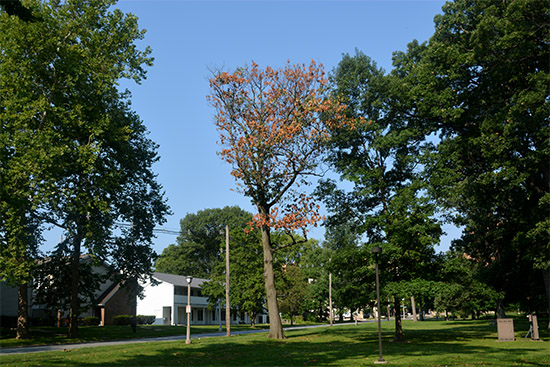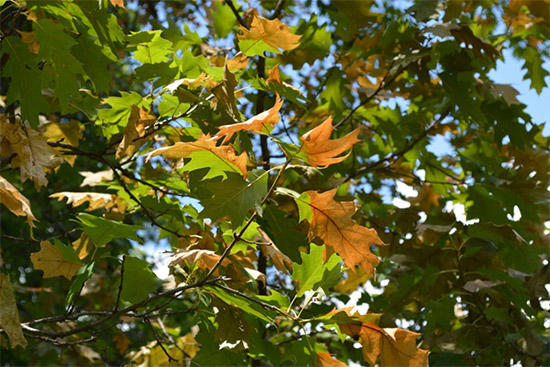Issue 12, July 30, 2018
Oak Wilt
Oak wilt is a serious fungal disease which continues to kill oak trees in residential areas, parks, farm woodlots, and forests throughout Illinois. The oak wilt pathogen was first detected in Wisconsin in 1944 and has slowly spread throughout the central and eastern United States, including across Illinois. Oak trees are the only known host, with oaks in the red oak group (pointed leaf lobes) more susceptible than oaks in the white oak group (rounded leaf lobes).

Photo 1. Northern red oak killed by Oak Wilt (Ceratocystic fagacearum)
SYMPTOMS
Red and black oak group (pointed leaf lobes)
- Symptoms first appear at the top of the tree or at the tips of the lateral branches in late spring and early summer.
- Symptomatic leaves curl slightly and turn a dull pale green, bronze, or tan, starting at the leaf margins.
- Infected trees rapidly defoliate. By late summer, an infected tree is often bare of leaves.
- A brown or black discoloration usually develops in the current‐season sapwood of wilting branches.
- Once infected, oaks in the red and black group do not recover.
White oak group (rounded leaf lobes)
- Symptoms usually appear on scattered branches of the crown, and may be confused with general dieback and decline.
- Leaves on infected white oaks become light brown or straw‐colored from the leaf tip toward the base. Leaves curl, but often remain attached to the branches.
- The trees may die in one year, but usually die slowly over a period of several years or more.

Photo 2. Oak wilt foliar symptoms on northern red oak.
PATHOGEN
Oak wilt is caused by the fungal pathogen Ceratocystis fagacearum. The pathogen moves from diseased to healthy trees in two ways, through root grafts formed naturally between oak trees of the same group and through fresh wounds via sap‐feeding insect vectors. Within a few days of infection, balloon‐like tyloses and gums begin to plug the water conducting tissue within the tree, blocking the flow of water and nutrients from the roots to the foliage. As the supply of water becomes restricted, leaves wilt and die.
DIAGNOSIS
If a tree is suspected of being infected with oak wilt, laboratory testing should be performed to confirm the diagnosis. Branches with symptomatic leaves attached should be submitted to a diagnostic laboratory. Ideally, branches are 10‐12 inches long and 1‐2 inches in diameter. Samples should be taken the day they are submitted. The oak wilt pathogen is sensitive to high temperatures, so samples must be kept cool in transit. If shipping samples, we recommend using a cold pack and an insulated shipping container. Ship via overnight or next‐day delivery, and avoid shipping late in the week.
MANAGEMENT
No complete control or cure for oak wilt exists. However, proper tree care plus mechanical and chemical control measures can keep the disease from spreading to healthy trees nearby.
Cultural Management
To reduce the risk of the pathogen entering the tree through wounds, it is highly recommended to avoid pruning oak trees in spring and early summer. The sap‐feeding beetles that act as vectors for the oak wilt fungus are attracted to fresh wounds, which also act as a pathway for the pathogen to enter the tree. In Illinois, oak wilt is at the highest risk of spreading during April, May, and June due to increased beetle activity. While the risk of infections via pruning wounds may decrease by mid‐July, those erring on the side of caution should choose to postpone any pruning until dormancy. When pruning cannot be delayed, wound dressings and latex‐based paints have shown some effectiveness in reducing the potential for oak wilt transmission when applied immediately to a fresh wound. These products are believed to reduce the attractiveness of the wound to the insect vector and/or prevent the entry of oak wilt fungal spores into the vascular system of the wounded tree.
Chemical Management
Fungicide injections with propiconazole can be used to protect high value, healthy trees. Tree injections should only be made by trained arborists or others trained in injection techniques and diagnosis of oak wilt. Fungicides should be used in combination with the other strategies discussed in this fact sheet. Therapeutic injections can be effective on species within the white oak group when used early in the infection (less than 30% crown affected). However, researchers and practitioners tend to agree that it is rarely worth the expense to inject members of the red oak group that are infected with oak wilt.
REMOVAL AND DISPOSAL OF INFECTED TREES
Timely removal and proper disposal of diseased oak trees is critical for preventing the spread of the pathogen. If a diagnosis of oak wilt is confirmed, the infected tree should be removed as quickly as possible and the root zone should be trenched to break potential root grafts if there are any oak trees of the same group nearby. Ideally, the trenching is done before or just after removal of the infected tree. Trenching can be accomplished via mechanical or chemical means. The use of diseased oaks for firewood is not recommended. Firewood is frequently not burned before the following spring when trees killed by oak wilt develop fungal spore mats beneath their bark. Beetle vectors will pick up fungal spores as they breed in and feed on the fungus mats. The insects then spread the fungus as they fly to healthy oak trees and feed on the sap oozing from fresh wounds. If diseased wood is to be used, it should be debarked, cut to the proper length, split, stacked off of the ground, and protected from moisture in order to hasten drying. Wood that has been debarked or stored in a dry place for more than one year is not a source of infection.
Additional Resources
- University of Illinois Plant Clinic http://web.extension.illinois.edu/plantclinic
- Report on Plant Disease: Oak Wilt and Its Control http://ipm.illinois.edu/diseases/rpds/618.pdf
- Plant Clinic Report: Oak Problems http://web.extension.illinois.edu/plantclinic/downloads/Plant%20Clinic%20Report%20Oak%20LO.pdf
(Travis Cleveland and Diane Plewa)
Authors:
Travis Cleveland
Diane Plewa